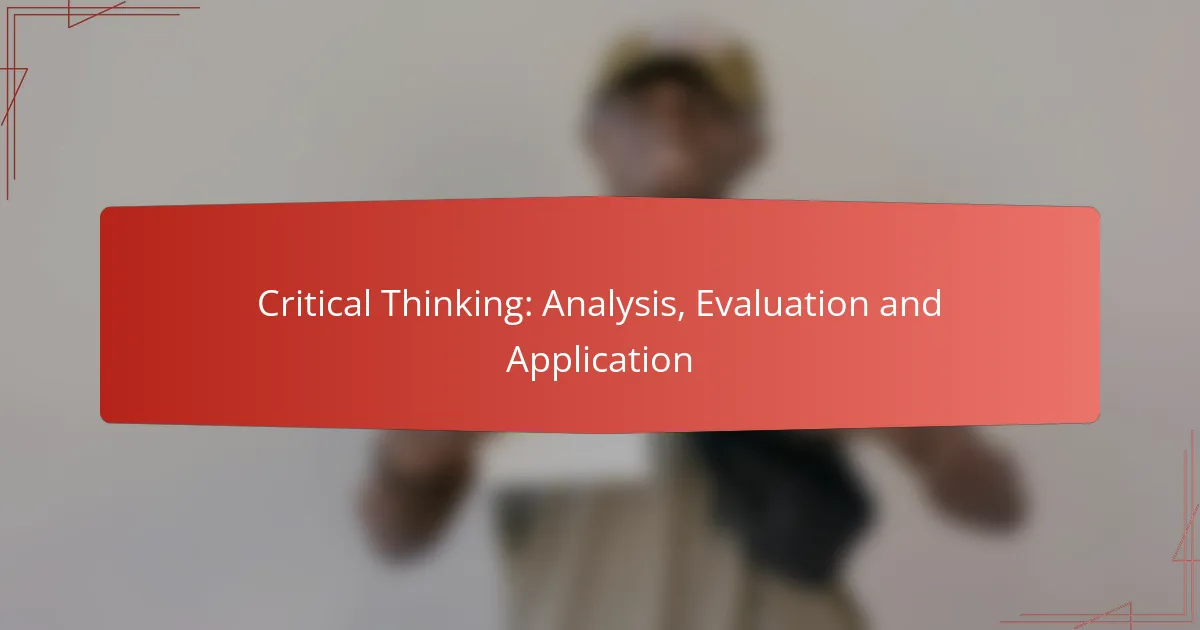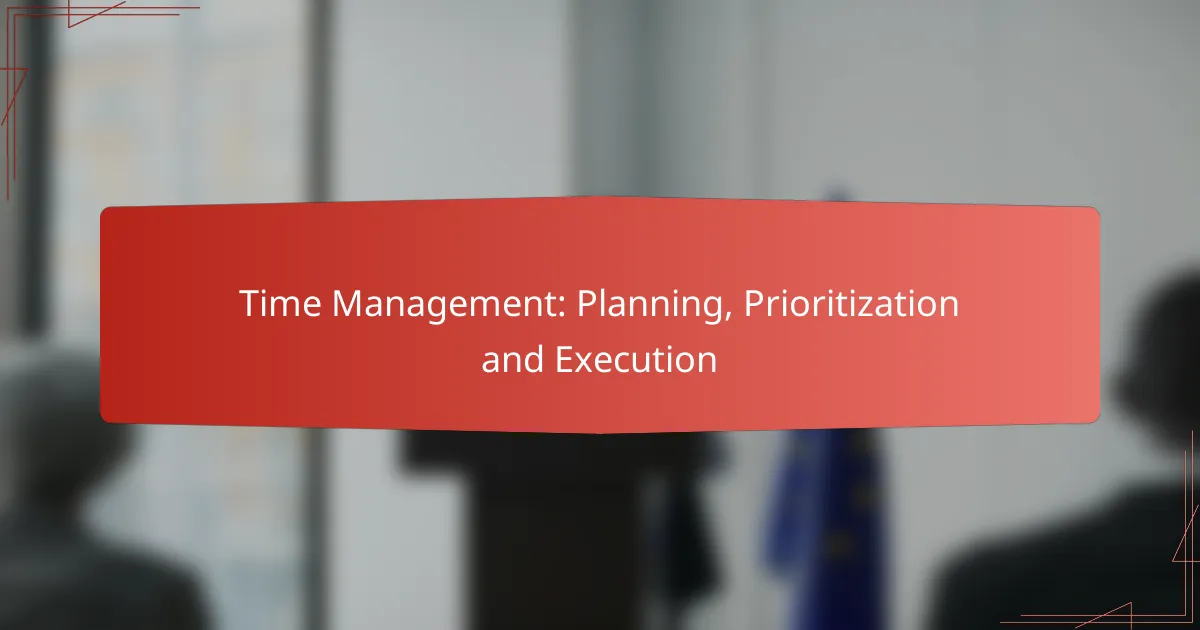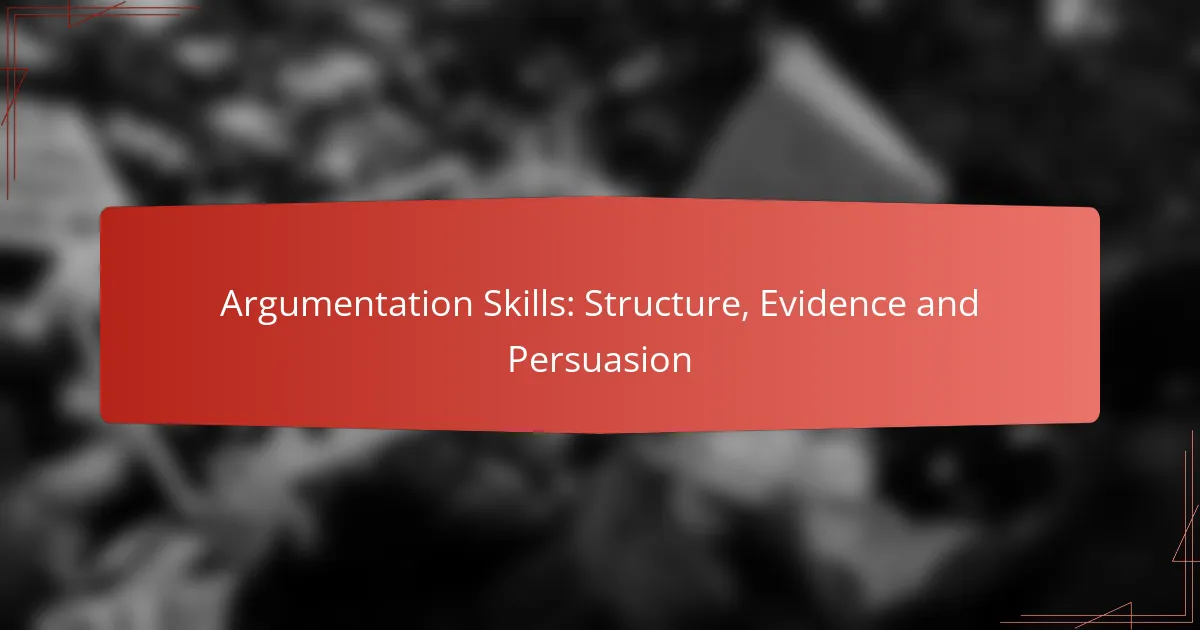Critical thinking is an essential skill that empowers individuals to analyze information, evaluate options, and apply logical reasoning in decision-making. By honing these skills, one can make more informed choices, minimize errors, and achieve better outcomes. The process involves a structured approach to assessing information and solving problems effectively.
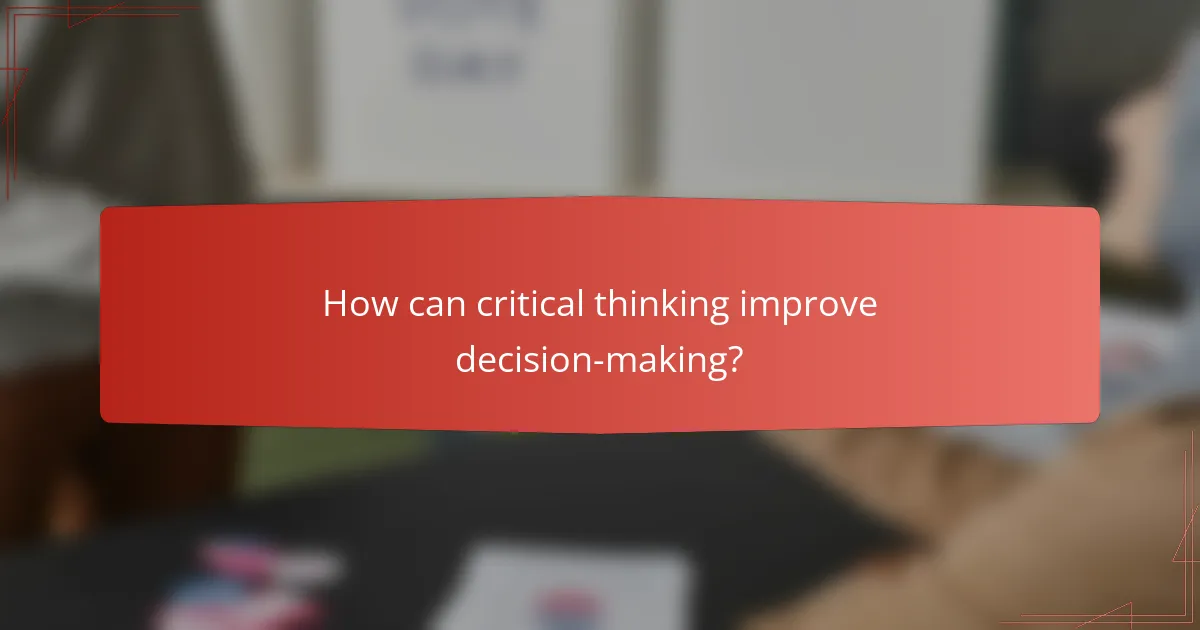
How can critical thinking improve decision-making?
Critical thinking enhances decision-making by enabling individuals to analyze information, evaluate options, and apply logical reasoning. This process leads to more informed choices, reducing the likelihood of errors and improving outcomes.
Enhanced problem-solving skills
Critical thinking fosters enhanced problem-solving skills by encouraging a systematic approach to identifying issues and generating solutions. By breaking down complex problems into manageable parts, individuals can analyze each component effectively.
For example, when faced with a business challenge, a critical thinker might outline the problem, gather relevant data, brainstorm potential solutions, and evaluate the pros and cons of each option. This structured method often leads to more effective resolutions.
Informed risk assessment
Informed risk assessment is a key benefit of critical thinking, as it allows individuals to weigh potential risks against possible rewards. By critically evaluating the likelihood and impact of various outcomes, decision-makers can make more balanced choices.
For instance, when considering an investment, a critical thinker will assess market trends, financial health, and external factors, leading to a more nuanced understanding of the risks involved. This thorough analysis can prevent costly mistakes.
Effective communication
Effective communication is enhanced through critical thinking, as it promotes clarity and coherence in expressing ideas. Critical thinkers are better equipped to articulate their reasoning and engage in constructive discussions.
In practice, this means presenting arguments logically, supporting claims with evidence, and anticipating counterarguments. For example, during team meetings, a critical thinker can facilitate dialogue by clearly outlining their perspective and encouraging others to share their insights, leading to more productive outcomes.
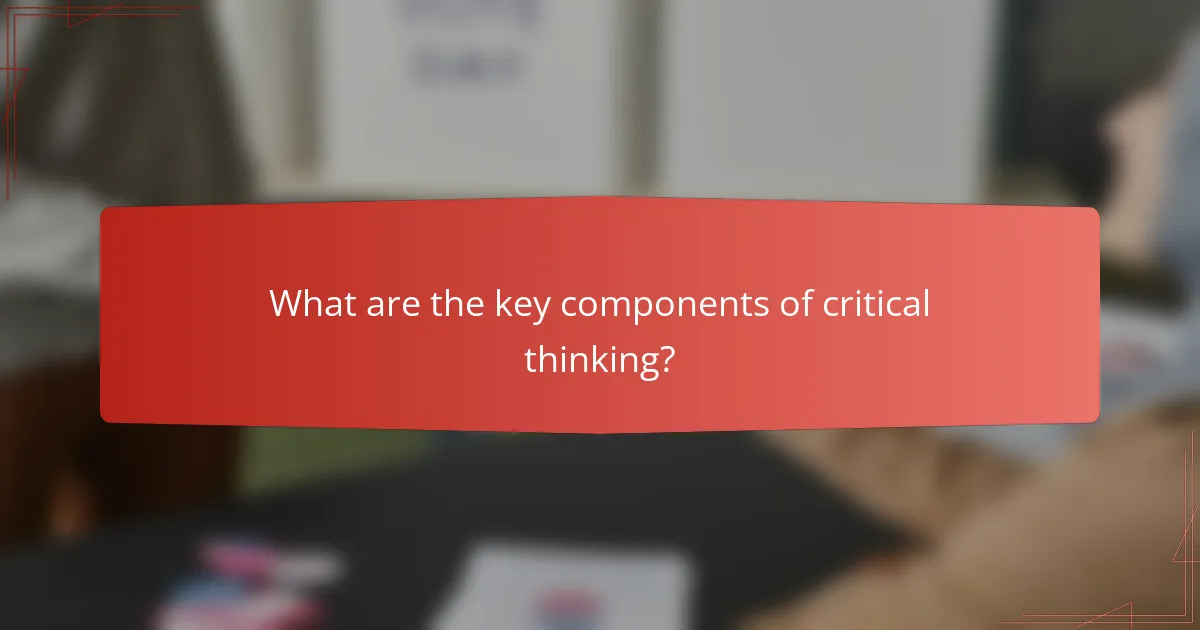
What are the key components of critical thinking?
The key components of critical thinking include analysis, evaluation, and application. These elements work together to help individuals assess information, make informed decisions, and solve problems effectively.
Analysis
Analysis involves breaking down complex information into smaller parts to understand it better. This process includes identifying assumptions, examining arguments, and recognizing patterns or inconsistencies. For example, when evaluating a news article, one should consider the source, the evidence presented, and any potential biases.
To enhance analytical skills, practice asking questions such as: What is the main point? What evidence supports this claim? Are there alternative viewpoints? This approach helps clarify thoughts and leads to more informed conclusions.
Evaluation
Evaluation is the process of assessing the credibility and relevance of information. This includes determining the reliability of sources, the strength of arguments, and the validity of conclusions. For instance, when reviewing a research study, consider the methodology, sample size, and potential conflicts of interest.
Effective evaluation requires a critical eye. Look for logical fallacies, check for supporting evidence, and weigh the pros and cons of different perspectives. This helps in forming a balanced viewpoint and making sound judgments.
Application
Application refers to the ability to use critical thinking skills in real-world situations. This involves taking insights gained from analysis and evaluation and applying them to solve problems or make decisions. For example, when faced with a business challenge, one might analyze market trends, evaluate potential strategies, and implement the most effective solution.
To improve application skills, practice applying critical thinking in daily scenarios. Start with small decisions, like evaluating a purchase or planning an event, and gradually tackle more complex issues. This builds confidence and enhances overall critical thinking abilities.
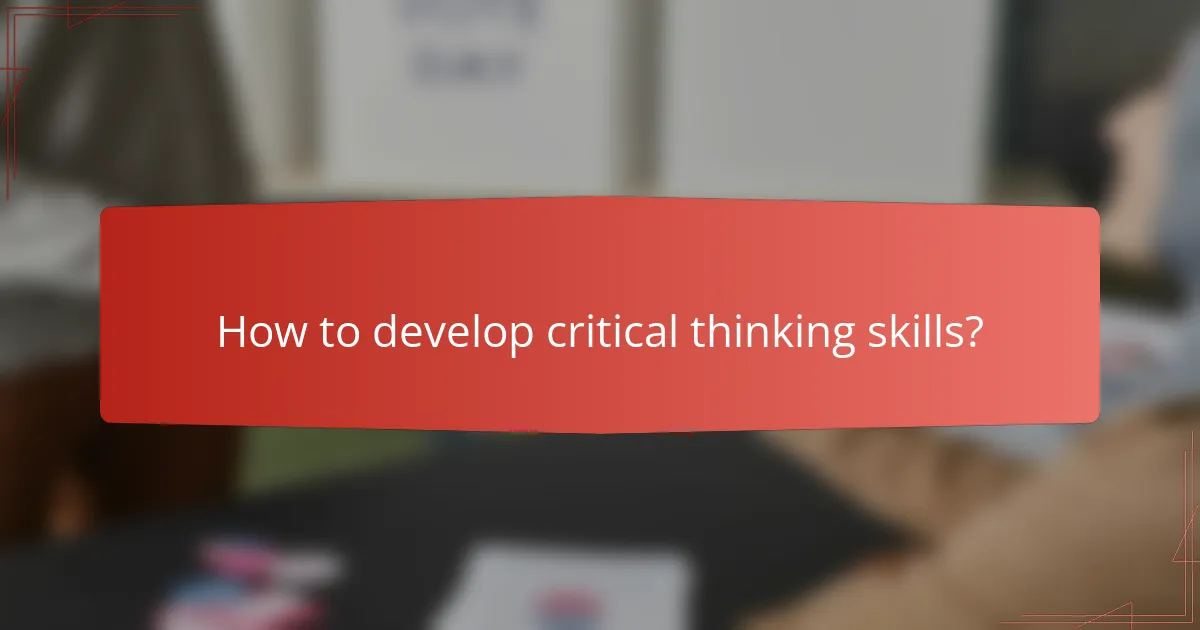
How to develop critical thinking skills?
Developing critical thinking skills involves enhancing your ability to analyze information, evaluate arguments, and apply reasoning effectively. This process requires practice, engagement, and the use of structured frameworks to guide your thinking.
Practice reflective thinking
Reflective thinking is the process of examining your own beliefs, values, and thought processes. To practice this, set aside time to consider your decisions and the reasoning behind them. Ask yourself questions like, “What led me to this conclusion?” and “What evidence supports my viewpoint?”
Keeping a journal can be an effective way to engage in reflective thinking. Write down your thoughts after discussions or decision-making processes to identify patterns in your reasoning and areas for improvement.
Engage in discussions
Engaging in discussions with others can significantly enhance your critical thinking skills. Conversations expose you to different perspectives and challenge your viewpoints, prompting deeper analysis. Seek out diverse groups to broaden your understanding and encourage constructive debate.
When participating in discussions, practice active listening. Focus on understanding others’ arguments fully before responding, which can help you refine your own reasoning and identify any biases in your thinking.
Utilize critical thinking frameworks
Critical thinking frameworks provide structured approaches to analyze and evaluate information systematically. Popular frameworks include the Socratic method, which involves asking a series of questions to stimulate critical thinking, and the Paul-Elder model, which emphasizes clarity, accuracy, relevance, and depth.
To apply these frameworks, start by defining the problem or question at hand. Use the framework to dissect the issue, considering various angles and evidence before arriving at a conclusion. This method not only enhances your analysis but also helps in making well-informed decisions.

What are common barriers to critical thinking?
Common barriers to critical thinking include cognitive biases, emotional reasoning, and a lack of knowledge. These obstacles can hinder effective analysis and evaluation, leading to flawed conclusions and poor decision-making.
Cognitive biases
Cognitive biases are systematic patterns of deviation from norm or rationality in judgment. They can lead individuals to make decisions based on subjective perceptions rather than objective evidence. For instance, confirmation bias causes people to favor information that confirms their existing beliefs, ignoring contradictory data.
To mitigate cognitive biases, individuals should actively seek diverse perspectives and challenge their assumptions. Keeping a journal of decisions and the reasoning behind them can also help identify and correct biased thinking over time.
Emotional reasoning
Emotional reasoning occurs when individuals allow their feelings to dictate their conclusions instead of relying on factual analysis. This can lead to distorted thinking, where emotions override logical evaluation. For example, someone might reject a valid argument simply because it evokes negative feelings.
To combat emotional reasoning, it’s essential to recognize when emotions are influencing thoughts. Practicing mindfulness and taking a step back to assess the situation objectively can help maintain a balanced perspective.
Lack of knowledge
A lack of knowledge can significantly impede critical thinking, as individuals may not have the necessary information to analyze a situation effectively. This gap can result in misinformed decisions and an inability to evaluate arguments critically. For example, without understanding basic economic principles, one may struggle to assess the validity of financial claims.
To overcome this barrier, continuous learning is crucial. Engaging in educational resources, attending workshops, and participating in discussions can enhance knowledge and improve critical thinking skills. Additionally, asking questions and seeking clarification when faced with unfamiliar topics can foster a deeper understanding.
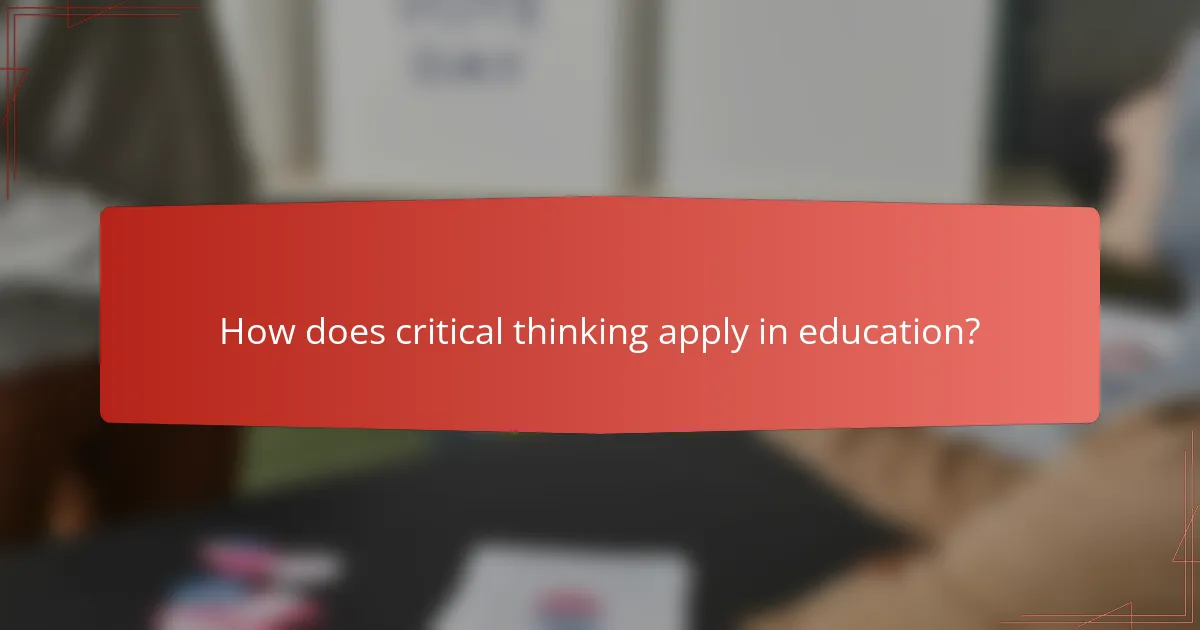
How does critical thinking apply in education?
Critical thinking is essential in education as it fosters analytical skills, enabling students to assess information and make informed decisions. By integrating critical thinking into various educational components, students learn to evaluate arguments, solve problems, and apply knowledge effectively.
Curriculum integration
Integrating critical thinking into the curriculum involves embedding it within subject matter across disciplines. This can be achieved by designing lessons that require students to analyze case studies, engage in debates, or solve real-world problems. For instance, a science class might include experiments that prompt students to hypothesize and evaluate outcomes critically.
Additionally, interdisciplinary projects can enhance critical thinking by allowing students to draw connections between different subjects. For example, a project that combines history and literature can encourage students to analyze historical contexts and their influence on literary themes.
Assessment methods
Assessment methods that promote critical thinking often go beyond traditional tests. Formative assessments, such as peer reviews and reflective journals, encourage students to articulate their thought processes and evaluate their understanding. These methods can provide insights into students’ critical thinking skills and areas for improvement.
Performance-based assessments, like presentations or group projects, can also effectively measure critical thinking. These assessments require students to synthesize information and present their findings, demonstrating their ability to analyze and evaluate content critically.
Teaching strategies
Effective teaching strategies for fostering critical thinking include the Socratic method, which encourages dialogue and questioning. This approach helps students develop their reasoning skills by challenging them to think deeply about their responses and the rationale behind them.
Incorporating problem-based learning is another strategy that enhances critical thinking. By presenting students with complex, real-life problems, educators can guide them to research, collaborate, and devise solutions, thereby honing their analytical skills in practical contexts.
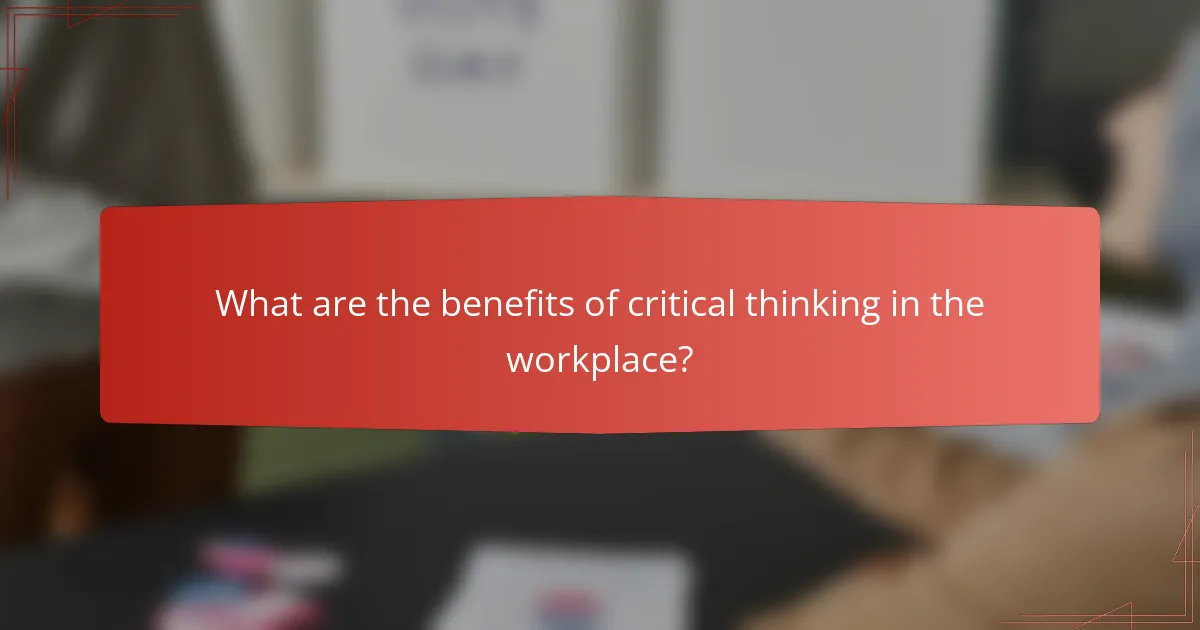
What are the benefits of critical thinking in the workplace?
Critical thinking in the workplace enhances decision-making, problem-solving, and communication. By applying analytical skills, employees can assess situations more effectively and propose innovative solutions.
Improved Decision-Making
Critical thinking leads to better decision-making by encouraging individuals to evaluate options thoroughly. This process involves gathering relevant information, weighing pros and cons, and considering potential outcomes before arriving at a conclusion.
For example, a manager faced with budget cuts can use critical thinking to analyze various cost-saving measures, ensuring that the chosen strategy minimizes negative impacts on team morale and productivity.
Enhanced Problem-Solving Skills
Critical thinking fosters enhanced problem-solving skills by promoting a systematic approach to identifying issues and developing solutions. Employees learn to break down complex problems into manageable parts, making it easier to tackle each component effectively.
A team encountering a drop in sales might apply critical thinking to investigate underlying causes, such as market trends or customer feedback, allowing them to devise targeted strategies to boost performance.
Better Communication
Effective communication is a key benefit of critical thinking, as it encourages clarity and precision in conveying ideas. Critical thinkers can articulate their thoughts logically, making it easier for colleagues to understand and engage with their viewpoints.
For instance, during a project presentation, a critical thinker can present data and insights in a structured manner, facilitating constructive discussions and collaborative decision-making among team members.
